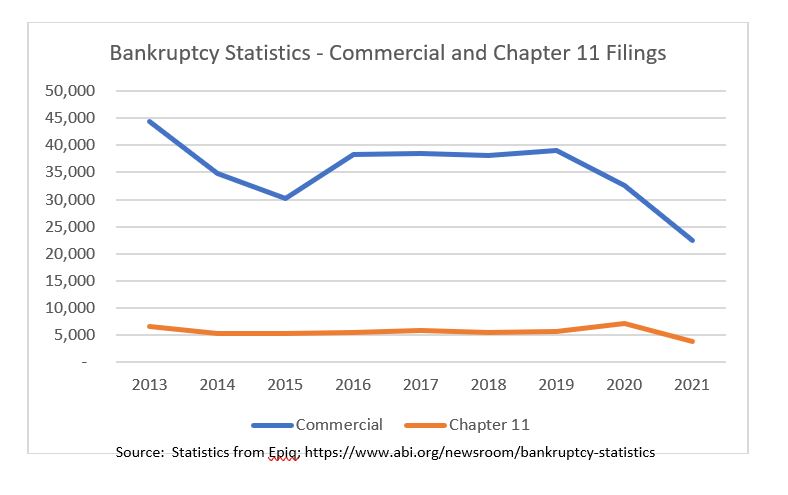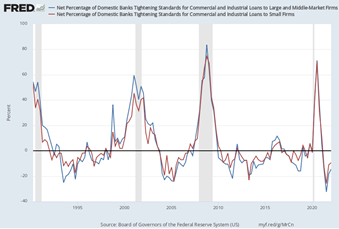- Karen Marino Joins JPalmer Collective as Head of Risk Management
- Back To The Future – The Advent Of Re-Shoring And Its Impact On Secured Financing
- M&A Market Set to Broaden as Confidence Surges
- Celebrating the Achievements of SFNet Chapters
- Saks Mulls Bankruptcy After Raising Billions for Turnaround
Bankruptcy & Restructuring - Where are we Now? Update 2022
May 9, 2022
By Patrick Diercks and Jackie Reinhard

Patrick Diercks, PKF Clear Thinking and Jackie Reinhard, PKF O’Connor Davies
The last two years have been a roller coaster for businesses. The early pandemic lockdowns initially wreaked havoc on small businesses; and then we saw what some consider to be a market overcorrection. Relief came in the form of PPP loans, Main Street Lending, and various other subsidies and programs. We look to the data – year over year commercial bankruptcy filings are down 31% and Chapter 11 filings are down 48%. Comparing 2021 to 2019, commercial bankruptcy filings are down 31% and Chapter 11 filings are down 33%.
For small businesses that filed for bankruptcy in the last two years, the implementation of subchapter V occurred in early 2020. The USTP reports that early indications are subchapter V cases are being confirmed more quickly than small business cases not electing subchapter V[1].

[1] https://www.justice.gov/ust/page/file/1384576/download
Lenders are saying their outstandings are the lowest they’ve been in years. The graph below depicts a lessening of standards for commercial and industrial lending since the pandemic began, starting in Q2 2021[2]. The Federal Reserve’s Senior Loan Officer Opinion Survey on Bank Lending Practices[3] revealed that respondents reported easier standards and stronger demand for commercial and industrial loans, as well as commercial real estate loans. While there may be a lessening of credit restrictions in the lending community, any fallout from these policies will lag. Continued monitoring and scrutiny of financial health and performance is key to balancing the risk of loans extended in these conditions.

[2] https://fred.stlouisfed.org/graph/?g=cAWU
[3] https://www.federalreserve.gov/data/sloos/sloos-202201.htm
A more significant change coming from the pandemic is where and how people work, with many more people working remotely at least part of the workweek. One thing we keep reminding our clients is not to forget to reassess their internal controls and IT security policies and adapt to the changing work environment.
Influences
The term that has been thrown around in various facets the past two years – “the new normal.” Businesses continue to prosper and are now finding themselves limited by their ability to retain and hire talent and, in some cases, dealing with the continued supply chain issues plaguing the world. Supply chain issues is a topic to watch as this could present challenges to certain sectors that rely on asset-based lending where there could become an obsolescence or contract performance issues with materials delays.
One trend we’ve seen is a greater desire to solve workforce challenges with outsourcing, such as accounting and bookkeeping support, financial support services, and IT security and special projects. For those businesses that have taken advantage of the opportunity to reduce the reliance on fixed overhead charges and add greater scalability to their cost structures, they are now all the more prepared for any unforeseen changes in the business environment and can likely survive the drastic shifts in the macro environment we have seen over the last couple of years.
Where are we going?
Analyst predictions on what 2022 holds for restructuring and bankruptcy are mixed. Did the 2020 federal stimulus set in motion an inflationary problem that will come to a head in 2022? Are businesses going to continue to flourish with the current availability of capital? One thing we continue to advise clients, businesses and lenders alike, is to not let their guard down in (perceived) good times. What might we see? Continued issues related to both the supply chain, a tight labor market, and rising costs will start to hinder middle-market growth and, if nothing else, cut into some of the historically high levels of profitability and liquidity that many businesses have experienced over the last two years. For those businesses that did not take advantage of the opportunity to right size/fix any underlying issues during the pandemic, these challenges will likely re-expose pre-pandemic issues, and force the need for some level of change. Additionally, changes in consumer spending habits due to both inflation and the presumed relaxation of COVID related restrictions will likely reverse some of the good fortune that certain sectors have seen due to COVID (home goods, delivery services, light construction, etc.) and have the opposite effect on sectors such as travel, entertainment, and restaurants. That being said, the conflict between Russia and Ukraine is already having a significant impact on fuel prices, and the sanctions placed on Russia combined with the likelihood that the myriad of products previously exported from Ukraine will come to a halt in the short term could have disastrous effects on businesses that rely on these products and will force them to source replacements for raw materials from more expensive providers. These challenges will almost certainly exacerbate the current inflationary period and will likely put a damper on overall consumer spending and may limit the potential boon to the aforementioned sectors a shift in spending would have led to.
Prior to the issues in Ukraine/Russia, there was likely to be an increase in regulatory pressures on bank lenders as to the classification of non-performing loans. Given those issues and the resulting actions the U.S. has taken, it is now somewhat unlikely that the OCC will put much pressure on lenders in the near term to re-classify loans until they have a better understanding as to the ultimate effects of the economic sanctions and related supply chain issues. For those clients already facing low levels of liquidity the macroeconomic issues related to the Ukraine/Russia conflict will likely increase their need for additional capital. Fortunately, there would still appear to be a significant amount of capital available to assist these clients in the secondary financing world, and while the access to that capital will be more expensive, it will likely provide a necessary lifeline to these businesses in the near term. Given the likelihood of the Federal Reserve raising interest rates to try and curb inflation, cost of capital is also likely to increase, and despite the current historically low interest rates, any increase in this cost is going to be that much more pressure on those businesses with already low levels of liquidity.
ESG
Environmental, Social and Governance (ESG) requirements will continue to see a greater level of focus as it relates to underwriting the capital needs of businesses. Regardless of whether capital is being provided by a regulated bank, the private lending community, or private equity, the importance of incorporating ESG into a business’s overall strategy cannot be understated. The regulated bank community is already starting to utilize covenants surrounding ESG related to certain pricing metrics while underwriting loans. For borrowers, starting to put the proper ESG protocols in place now will be very important for increased access to capital, as well as lower costs of capital in the future.
White Collar Investigations/Bankruptcy-Related Crimes
The United States Trustee Program (USTP) made 2,489 bankruptcy and bankruptcy-related criminal referrals during Fiscal Year (FY) 2020. This represents a 9.2% increase from the 2,280 criminal referrals made during FY 2019. The five most common allegations contained in the FY 2020 criminal referrals involved tax fraud (63.2%), false oaths or statements (19.8%), a bankruptcy fraud scheme (16.6%), concealment (15.7%) and identity theft or use of false/multiple social security numbers (14.6%). USTP is committed to identifying and referring for investigation and prosecution bankruptcy fraud and bankruptcy-related crimes. While the pandemic may provide certain logistic challenges in bringing bankruptcy-related criminals to justice, the increase in criminal referrals year over year indicates that this did not deter USTP from continuing to carry out the mission of the program. We would expect to continue to see an increase in white-collar crime and bankruptcy-related crimes based on the performance of USTP over the past 10 years and the continued focus of USTP and other enforcement groups on combating fraud and protecting the integrity of the bankruptcy system[4].
Municipal Solvency
It’s not news that many municipalities and states had been facing growing fiscal challenges prior to the pandemic. In April 2020, Mitch McConnell suggested that states should be allowed access to file bankruptcy similar to cities and local governments[5]. Puerto Rico was able to restructure its debt when it filed in 2017 through PROMESA, which the U.S. Congress passed in 2016. Early in 2020, states were ravaged with various pandemic-related fiscal issues like tax collections, but $350 billion in federal aid came to the rescue in 2021 with the passing of the American Rescue Plan Act. States’ balance sheets have been propped up with these monies, however, inflationary pressures combined with pre-pandemic issues like unfunded pension and retirement obligations could chip away at this newfound surplus.
[4] https://www.justice.gov/ust/page/file/1431611/download
[5] https://www.reuters.com/article/us-health-coronavirus-usa-states/mcconnell-says-he-favors-state-bankruptcy-over-more-federal-aid-idUSKCN2242U7
About the authors:
Pat has over 17 years of experience as a consultant in the turnaround/restructuring arena dealing primarily with companies in the consumer product manufacturing/distribution, staffing, metal products, manufacturing and retail industries. He has led/participated in numerous assignments related to cash management and operational performance improvement, as well as frequently serving as financial advisor to various constituents in bankruptcy proceedings.
Pat has assisted clients with the preparation and analysis of business plans, financial statements, cash flow reporting and forecasting, collateral analysis and monitoring, out-of-court wind-downs, refinancing, organizational restructuring, labor standards development, and POS implementation/training.
He has provided services to both debtors and creditors within the Chapter 11 bankruptcy process including: the preparation of cash collateral forecasts, DIP budgets, claims analysis, asset analysis and recovery, and estate wind-down activities.
Additionally, he has served as both a Chief Restructuring Officer and Chief Strategy Officer as well as other interim senior management roles. Pat has also been retained by numerous bankruptcy estate trustees/plan administrators to assist with post- confirmation activities and managing/administering the plan.
Jackie Reinhard is a Principal in the Business Advisory practice at DGC, a division of PKF O’Connor Davies, and has over 15 years of experience in public accounting and financial reporting. She provides financial advisory consulting services for complex commercial litigation, as well as bankruptcy and restructuring.
Jackie works with clients on a variety of matters including fraud and forensic investigation, economic damages, business interruption, and other complex accounting matters. She has served as a member of the financial advisor team for debtors' committees, including one of the largest bankruptcies in U.S. history, and has performed various complex analyses of solvency and legal debt limits.
Jackie also has experience providing audit and advisory services to private businesses with an emphasis on private investment companies and real estate. Her clients have spanned various sectors of the financial services and real estate industries, including investment funds, development, hotel, commercial/retail and multi-family.
Prior to joining the Firm, Jackie started her career at an international public accounting firm and then moved to a boutique private equity real estate investment firm as director of investor and financial reporting.

.jpg?sfvrsn=f1093d2a_0)
